Abstract
Adaptation and innovation are extremely important to the manufacturing industry. This development should lead to sustainable manufacturing using new technologies. To promote sustainability, smart production requires global perspectives of smart production application technology. In this regard, thanks to intensive research efforts in the field of artificial intelligence (AI), a number of AI-based techniques, such as machine learning, have already been established in the industry to achieve sustainable manufacturing. Thus, the aim of the present research was to analyze, systematically, the scientific literature relating to the application of artificial intelligence and machine learning (ML) in industry. In fact, with the introduction of the Industry 4.0, artificial intelligence and machine learning are considered the driving force of smart factory revolution. The purpose of this review was to classify the literature, including publication year, authors, scientific sector, country, institution, and keywords. The analysis was done using the Web of Science and SCOPUS database. Furthermore, UCINET and NVivo 12 software were used to complete them. A literature review on ML and AI empirical studies published in the last century was carried out to highlight the evolution of the topic before and after Industry 4.0 introduction, from 1999 to now. Eighty-two articles were reviewed and classified. A first interesting result is the greater number of works published by the USA and the increasing interest after the birth of Industry 4.0.
1. Introduction
Smart production systems require innovative solutions to increase the quality and sustainability of manufacturing activities while reducing costs. In this context, artificial intelligence (AI)-driven technologies, leveraged by I4.0 Key Enabling Technologies (e.g., Internet of Thing, advanced embedded systems, cloud computing, big data, cognitive systems, virtual and augmented reality), are ready to generate new industrial paradigms [1].
In this regard, it is interesting to remember that the father of artificial intelligence, John McCarthy [2], in the 1990s, defined artificial intelligence as “artificial intelligence is the science and engineering of making intelligent machines, especially intelligent computer programs”. Generally, the term “AI” is used when a machine simulates functions that humans associate with other human minds, such as learning and problem solving [3].
On a very broad account, the areas of artificial intelligence are classified into 16 categories [4,5,6,7,8]. These are reasoning, programming, artificial life, belief revision, data mining, distributed AI, expert systems, genetic algorithms, systems, knowledge representation, machine learning, natural language understanding, neural networks, theorem proving, constraint satisfaction, and theory of computation [9,10,11].
In the 21st century, AI has become an important area of research in all fields: Engineering, science, education, medicine, business, accounting, finance, marketing, economics, stock market, and law, among others [12,13,14,15,16,17,18]. The range of AI has grown enormously since the intelligence of machines with machine learning capabilities has created profound impacts on business, governments, and society [19]. They also influence the larger trends in global sustainability. Artificial intelligence can be useful to solve critical issue for sustainable manufacturing (e.g., optimization of energy resources, logistics, supply chain management, waste management, etc.). In this context, in smart production, there is a trend to incorporate AI into green manufacturing processes for stricter environmental policies [20]. In fact, as said in March 2019 by Hendrik Fink, head of Sustainability Services at PricewaterhouseCoopers, “If we properly incorporate artificial intelligence, we can achieve a revolution with regard to sustainability. AI will be the driving force of the fourth industrial revolution” [21].
Thus, subfields of AI, such as machine learning, natural language processing, image processing, and data mining, have also become an important topic for today’s tech giants. The subject of AI generates considerable interest in the scientific community, by virtue of the continuous evolution of the technologies available today.
The development of ML as a branch of AI is now very fast. Its usage has spread to various fields, such as learning machines, which are currently used in smart manufacturing, medical science, pharmacology, agriculture, archeology, games, business, and so forth.
According to the above considerations, in this work, a systematic literature review of research from 1999 to 2019 was performed on AI and the ML technique. Therefore, it is considered necessary to create a classification system that refers to the articles that jointly treat the two topics, in order to have greater variance and reflection. Furthermore, to gain a deeper understanding, the influence of other variables was explored, such as the thematic areas and the sectors in which the technologies are most influential. The main contribution of this work is that it provides an overview of the research carried out to date.
A number of impressive documentations of established research methods and philosophy have been discussed for several years. Unfortunately, little comparison and integration across studies exists. In this article, a common understanding of AI and ML research and its variations was created.
This paper is not attempting to provide an all-encompassing framework on the literature on AI and ML research. Rather, it attempts to provide a starting point for integrating knowledge across research in this domain and suggests paths for future research. It explores studies in certain novel disciplines: Environmental pollution, medicine, maintenance, manufacturing, etc.
Further research is needed to extend the present boundary of knowledge in AI by integrating principles and philosophies of some traditional disciplines into the existing AI frameworks [22,23,24].
The target that this document would like to assume is not the trigger of a sudden proliferation of an already consolidated sector, but it is hoped that this research could be an important intellectual tool for both the refocusing of the work and creating new intellectual opportunities. This paper presents valuable ideas and perspectives for undergoing research on AI and ML.
The final aim was to anticipate the transformation of the discipline in the future age. This would be a journey that may experience change in its course as new generations of scholars contribute to the dialogue and to the action. As noted earlier, this work presents a review, hence it lays a foundation for future inquiry. It not only offers a basis for future comparisons but prompts a number of new questions for investigations as well. While topics that might be considered as results of this work are numerous, some are of particularly broad interest or impact.
2. Methodology
The methodological approach used mixes bibliometric, content analysis, and social network techniques. In this study, a state-of-the-art research was conducted through the SCOPUS and Web of Science databases. For the publication time span, the time from 1999 to 2019 was considered with the intent to understand how the level of attention towards the topic has changed before and after the introduction of Industry 4.0. The research methodology chosen for this study was a systematic literature review [25]. The main phases of the study were as follows:
- 1.
- Phase 1: Research and Classification. The present phase was divided into three steps:
- Step 1: Identification;
- Step 2: Screening; and
- Step 3: Inclusion.
In phase 1, bibliometric data was collected (step 1). Then, a screening of the overall result was carried out to identify which documents can be taken into consideration, in line with the research areas deemed interesting and relevant (step 2). At the end of this step, the last step (step 3) aimed to select the documents to be analyzed in detail.
- 2.
- Phase 2: Analysis. Once phase 1 was completed, the next phase was phase 2, which was the analysis of the results. The approach used for the bibliometric analysis included:
- The use of indicators for the parameters studied; and
- SNA (social network analysis) for the keywords.
The indicators chosen to perform the analysis were total papers (TPs), which is the total number of publications, and total citations (TCs), which is the total number of citations.
SNA finds application in various social sciences, and has lately been employed in the study of various phenomena, such as international trade, information dissemination, the study of institutions, and the functioning of organizations. The analysis of the use of the term SNA in the scientific literature has undergone exponential growth in the use of this mode of computable representation of complex and interdependent phenomena. For the purpose of the study, UCINET, NetDraw software was used, which was expressly designed for the creation and graphic processing of networks, and was used to represent the keywords in the network, and Excel for data input.
The software UCINET, NetDraw returned a sociometric network that describes the relationships between the classes, that is, data entered as input.
Furthermore, NVivo 12 software, the leading program for computer-assisted qualitative analysis (CAQDAS), was used to analyze keywords of all documents. In this specific case, it was used to identify the possible links between the keywords of the various documents examined, developing conceptual schemes from which to make interpretative hypotheses.
- 3.
- Phase 3: Discussion. At the end of the second phase, a third and final one followed, where the results were discussed, and conclusions were drawn.
In Figure 1, the main phases and steps followed for the analysis are shown.
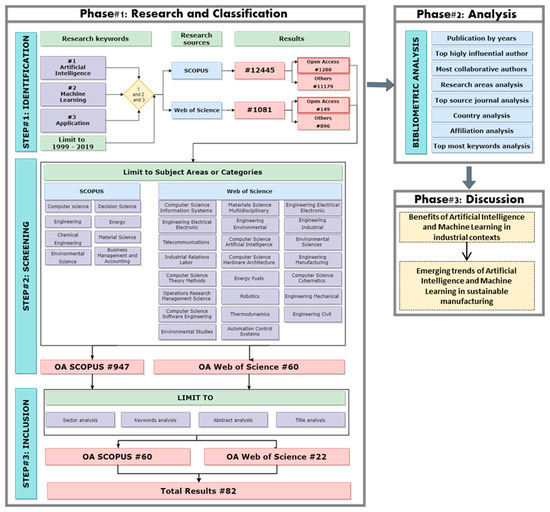
Figure 1.
Process flow chart.
3. Results of the Bibliometric Analysis
3.1. Phase 1: Research and Classification
The first phase consisted of the search for documents, which included the activities of collecting the material belonging to the academic universe. This first phase was divided into three steps as follows.
3.1.1. Identification (Step 1)
For a comprehensive survey of the phenomenon, an investigation on the Scopus (SCP) and Web of Science (WoS) databases was carried out using Boolean operators. We began by making a search query on the Scopus and WoS databases with the general keywords “artificial intelligence” AND “machine learning” AND “application”, as shown in Table 1.

Table 1.
Keywords and time period.
In order to maintain the consistency of the results, the same keywords were used in both databases and a time horizon of 20 years was chosen, from 1999 to 2019.
The choice of keywords for performing the survey was based on the awareness that AI and ML can be an important tool in the effort to adopt responsible business practices in the context of smart production. In this regard, it is worthy to note that with the increasingly urgent discussions of climate change, it seemed appropriate to focus our research on the topic of sustainability. Thus, the selection of papers also considered applications on sustainability.
The search returned in total 13,512 documents.
The results extracted by Scopus are numerically superior to Web of Science (WoS): 12,445 for the first and only 1081 for the second one (Table 2).

Table 2.
Total results of research on Scopus and WoS.
The result is not entirely unexpected, and the reason is to be found in the fact that Scopus, being an Elsevier product, collects data from all the other databases, in particular Science Direct and those queried by the Scirus search engine, while Web of Science (WoS) collects fewer documents.
From the documents extracted in Scopus, it was found that most of them are conference papers (57.28%) and, subsequently, articles (33.85%).
On the contrary, the research on Web of Science (WoS) underlines that most of the documents are articles (46.12%) and, subsequently, proceedings papers (42.86%).
All the document types are filled in Table 3.

Table 3.
Distribution of document types in Scopus and Web of Science.
AI began working in the 1940s and researchers showed strong expectations until the 1970s when they began to encounter serious difficulties and investments were greatly reduced.
Since then, a long period began, known as the “AI winter” [26]: Despite some great successes, such as IBM’s Deep Blue system, which in the late 1990s defeated the then chess world champion Garri Kasparov, the study of solutions for AI has only come back for a few years. The push for a new technological development has been given by the I4.0, which considered AI as one of the primary key enabling technologies (KETs).
From this period onwards, the literature has been enriched with documents, as shown in Figure 2. Growth is apparent after 2011 when new technologies began to be implemented more frequently. In fact, the Industry 4.0 term first appeared at Hannover Messe in 2011 when Professor Wolfgang Wahlster, Director and CEO of the German Research Center for Artificial Intelligence, addressed the opening ceremony audience.
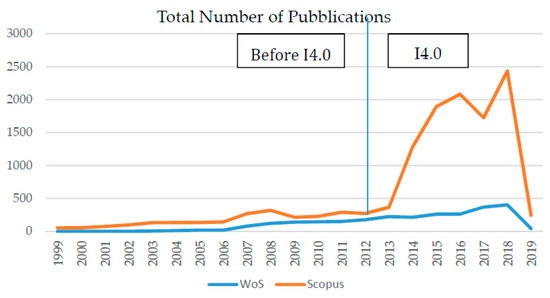
Figure 2.
Research growth on Scopus and Web of Science.
In fact, this research indicates that over the time period considered (1999–2019), the number of published articles remains almost constant until 2013, from which it undergoes an increase.
Subsequently, the increase in the adoption of these ones has led researchers to keep pace with the growth of I4.0 [27].
3.1.2. Screening (Step 2)
Trying to give an overview of the topics and areas interface, in the screening phase, an analysis of documents characterized by free access was chosen, excluding those that have restrictions, and to restrict the field to the thematic areas of scientific interest.
With this in mind, the number of open access items has been drastically reduced (1288 results for Scopus and 149 for WoS) and, also applying the filter related to the thematic areas (Table 4), it determined a further reduction: 947 for Scopus and 60 for WoS.

Table 4.
Subject area filter on Scopus and WoS.
Note how the number of filters applied is different. The databases, in fact, offer the same search options, but, in the specific case of the thematic areas, the latter are more numerous and structured on Web of Science (WoS) compared to Scopus.
3.1.3. Inclusion (Step 3)
At the end of the screening process, the inclusion step was started, which consisted in the selection of documents, which was extracted from the last passage, destined to be included in the sample on which bibliometric analysis was performed. In this review step, for the purposes of eligibility, we examined the complete text of each document independently. For each article, we examined whether there was interest from the academic world, and if it contained case studies or real applications, proposals for new AI and ML algorithms, or possible future scenarios.
Therefore, the final sample to be analyzed consisted of 60 documents for Scopus and 22 for WoS.
3.2. Phase 2: Analysis
This section presents and discusses the findings of this review.
First, an overview of the selected studies is presented. Second, the review findings according to the research criteria, one by one in the separate subsections, are reported.
3.2.1. Top Highly Influential Analysis
This section lists the most highly cited documents in WoS and Scopus. The list is structured by research source, date, title, authors, source title, and top citation (TP) in WoS or Scopus, according to the research source. The whole list is available in the Appendix A. Looking into the Appendix A, it is possible underline that the document by Larrañaga, Calvo, Santana et al. in 2006 [28] has the highest citation count of 298. This article reviews machine learning methods for bioinformatics and it presents modelling methods. Moreover, the document year is 2006, so before I4.0 was introduced. Therefore, having more years than today has an advantage in terms of diffusion. This means that it is one of the most influential documents in the academic world, as it proposes some of the most useful techniques for modelling, giving the document the opportunity to become a pioneer in the computer science research area.
Obviously, all documents before I4.0, in general, have more citations than the most recent documents. However, it is significant to note that even recent documents have a very high number of citations compared to the year of publication. This denotes the interest in the topic from the scientific community.
The citation analysis revealed that the first article that we can identify among the most cited in the I4.0 period dates to 2016. The work, published by Krawczyk [29], proposes application models to further develop the field of unbalanced learning, to focus on computationally effective, adaptive, and real-time methods, and provides a discussion and suggestions on the lines of future research in the application subject of the study. It received 119 citations. Moreover, an article published by Wuest, Weimer, Irgens et al. [30] received much attention among the scientific community. It contributes by presenting an overview of the available machine learning techniques.
Finally, the citation analysis pointed out that the average number of citations of all documents is 16.58. This value is expected to increase rapidly considering the interest in the issues of ML and AI.
3.2.2. Publications by Years
Consistent with what is defined in Section 3.1.1., the study shows that the number of items included in the analysis is definitely low for the entire period before I4.0 and then suddenly increases, starting in 2012. The data shown in Figure 3 also show two holes in the 2001–2008 and 2008–2011 intervals. This means that the technological applications were limited before it became an enabling technology of I4.0 in all respects, only to have a peak of technological implementation, as was foreseeable.
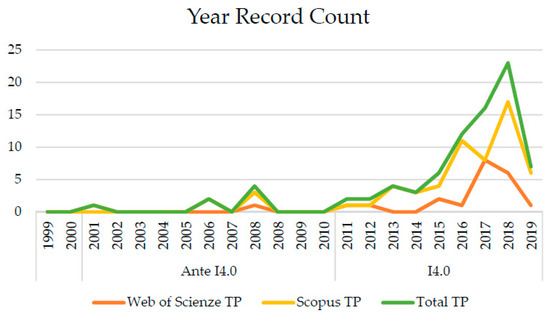
Figure 3.
Years of publications.
With reference to 2019, the figure refers to the first months of the year, so it is plausible that during the year, there will be a further increase in the documents in the literature. Furthermore, an increase is expected in the coming years, in parallel with the growth of I4.0
3.2.3. Most Collaborative Authors
The analysis highlighted that most of publications have more than one author. From this point of view, it is possible to identify the number of authors for each document. As shown in Figure 4, most of the manuscripts were produced by groups ranging from two to five authors. The indicators chosen to perform the analysis were total papers (TPs), which is the total number of publications.
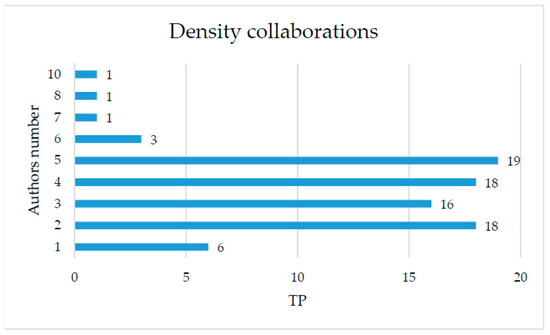
Figure 4.
Collaborative groups.
3.2.4. Research Areas Analysis
The total research area analysis collected from the 82 papers was 164 because each paper can be considered as more than one research area analysis. Given the small number of documents identified in the period before I4.0, the ranking refers mostly to the current industrial revolution. Also, in this case, the result is consistent with the introduction of paradigm 4.0, which has intensified research and the adoption of technology.
The first thematic areas and disciplines that are at the top of the ranking are computer science, engineering and biochemistry, genetics, and molecular Biology, respectively, with 29%, 23%, and 6% of publications. Furthermore, the other disciplines identified for which applicative findings are found are considered transversal to the first three disciplines and this is a consequence of I4.0. In terms of the percentage contribution, the first three areas cover about 60% of the papers considered.
Considering the top 20 research areas, given the frequency of the research areas’ distribution, Figure 5 shows a higher level of concentration in the disciplines indicated above.
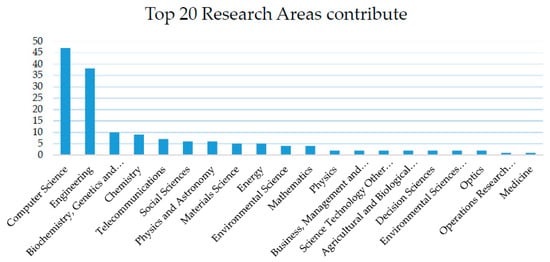
Figure 5.
Top 20 research areas contributions.
In fact, in terms of the percentage contribution, the first five areas cover about 70% of the papers considered. Regardless, by only counting research areas found once, there is a total of 27.
This means two things:
- The large number of fields in which this kind of research is involved; and
- Most papers have a transversal approach, that is, the object of each research crosses more than one field of application, thus involving more research areas.
This confirms the wide interest in these subjects from several fields.
3.2.5. Top Source Journals Analysis
In this section, the top 20 sources or journals that were published most frequently were extracted.
A journal is a time-bound publication with the objective of promoting and monitoring the progress of the discipline it represents.
In this specific case, the total source journals detected from the documents is 74, but, considering the top 20, given the frequency of the source journals’ distribution, only the first 13 sources have more than one paper published, with a total percentage contribution of 43% of the total.
After analyzing the sources separately, the results obtained in the two databases were found to not be the same. In WoS, the top source journal was IEEE Access with two publications while in Scopus, the top source journals are Procedia Computer Science, Matec Web of Conferences, and Machine Learning with four publications, which contribute 5% of the total.
Aggregating the data collected from the two databases, the ranking moves to that obtained by Scopus, making sure that IEEE Access is no longer first in the standings, but only eighth, and that the former are precisely those of Scopus: Procedia Computer Science, Matec Web Of Conferences, and Machine Learning, with the same number of publications. Next, the 10 source journals have a 3% publication contribution while the rest have a one-to-one relationship (1%) with the corresponding source journal.
The low level of concentration of the sources suggests that there is a great deal of interest in these topics from several scientific journals. As a matter of fact, it is foreseeable that specialized sector sources (AI Magazine and Machine Learning) are among the first 13; however, it is interesting to note that other sources are involved, such as Sustainability Switzerland or BMC Bioinformatics and Nuclear Engineering and Design.
Figure 6 shows the top 20 source journals contributions.
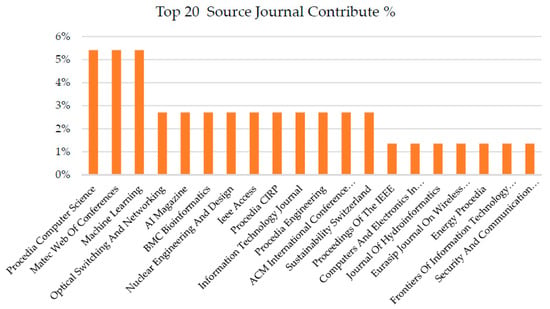
Figure 6.
Top 20 source journals contributions.
3.2.6. Country Analysis
The results that emerged through research on the two databases are consistent with each other. In both cases, in fact, the countries that give the greatest contribution to the research are China and the United States (Figure 8). The result is obvious since in China and the United States, more than 1.3 billion and 0.3 millions of people live, respectively, and so there are more researchers than in the single European nations. Focusing on Europe, Germany published more papers than any other European country. This is not a random result: I4.0 was born in Germany, so this outcome was expected. However, the following observation cannot be ignored from this data: The USA and China carry the first two places in the list while it is not the same for European countries. Europe, despite its talents and resources, has lost ground. Presenting its report on artificial intelligence, the French deputy and mathematician Cédric Villani declared that, “Europe must be able to compete with China and the United States while protecting its citizens and pointing the way to go on ethical issues”. If we are not careful, the 21st century rules will not be defined in Brussels, but in Shanghai. Artificial intelligence is also a land marked by intense geopolitical rivalry that could redefine global power relations.
Even so, regarding Europe, it is worthy to also note that since 2017, France, Germany, and Italy have intensified their trilateral cooperation to promote digitizing the manufacturing industry. In this regard, in the near future, we expect a significant evolution of smart production initiatives and therefore an increase in scientific research.
Figure 7 shows the country contribution distribution.
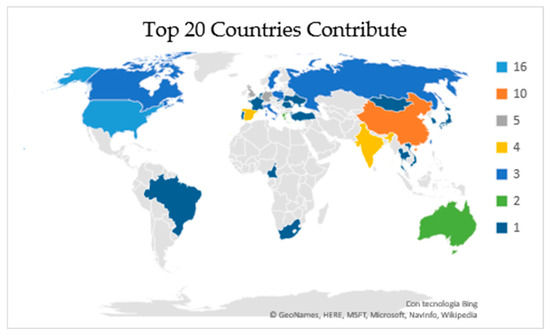
Figure 7.
Top 20 countries contributions.
3.2.7. Affiliation Analysis
The total number of affiliation detected from the 82 papers is 153. Also, in this case, considering the top 20, the frequency of the affiliation distribution shows that most papers have a one-to-one relationship with the corresponding affiliation. Only the first four affiliations have three papers (2% of the contribution) and the second four have two papers (1.3% of the contribution). This result gives us information about the wide interest on this subject from several universities and research centers all over the world. Then, the affiliation analysis confirms the result of the country analysis (Figure 8). In fact, if we try to sum the first eight affiliations by their own country, the outcome is:
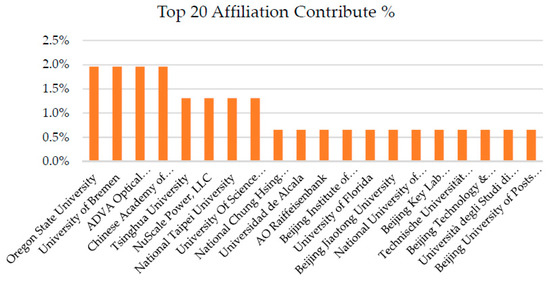
Figure 8.
Top 20 institute affiliations contributions.
- Nine papers from China;
- Six papers from Germany; and
- Five papers from the USA.
In September 2018, the most important event on artificial intelligence was held in Shanghai. China is very determined to focus on future technologies.
For some months, China has become the world’s leading power in terms of scientific publications. Late in the 20th century technologies, China chose to do what the English-speaking people call a “frog jump” and focus on 21st century technologies.
China, with its 800 million Internet users and without any privacy protection policy, has access to more personal data than the United States and Europe.
3.2.8. Top Keywords Analysis
Through NVivo 12, the top 20 keywords were extracted directly, which are those that always appear in association with each document.
Starting from this classification, the graphic representation, a word cloud shape, of the keywords (Figure 9) was extracted. It can be noted that the most used term is precisely “machine”, “learning”, and “intelligence”, which the software represents with greater characters than all the other terms.
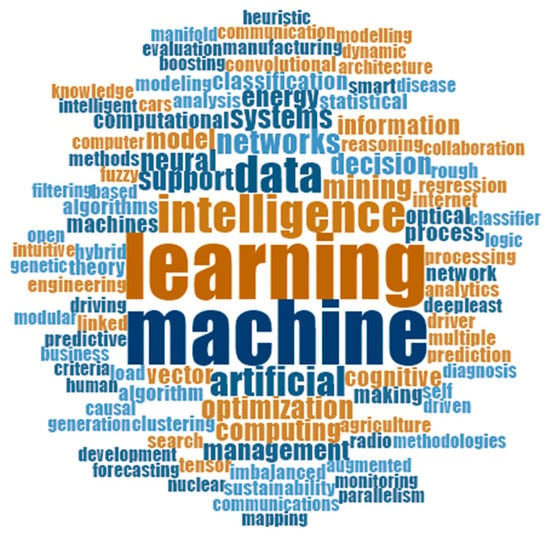
Figure 9.
Top 20 keywords cloud contribution by NVivo 12.
The font size describes how much the keyword is indexed. Another mode of representation is the tree words (Figure 10). Also, in this case, the most indexed words are those represented in the larger boxes.
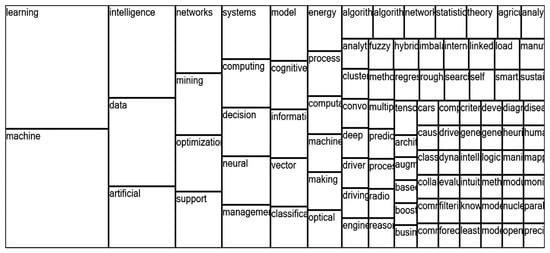
Figure 10.
Top 20 keywords tree contribution by Nvivo 12.
As expected, the most indexed words are obviously “learning”, “machine”, and “intelligence”, with high numbers. It is logical that among the first results, words that recall the technology itself were obtained, but it is interesting to note that words referring to other fields of AI applications are also indexed. The reason is to be found in the fact that AI and ML are technologies that cross all the sectors involved in I4.0 and that, therefore, do not remain circumscribed.
Specifically, words, such as “data”, “neural”, “decision”, and “management”, are very or average indexed, demonstrating the fact that AI also extends to many other sectors.
Another tool for the analysis for keywords is the UCINET software, through which social networks analysis is carried out.
Social network analysis (SNA), which is also often called social network theory, is a modern technology of social relations.
SNA finds application in various social sciences, and has recently been used in the study of various phenomena, such as international trade, information dissemination, the study of institutions, and the functioning of organizations. The analysis of the use of the term SNA in the scientific literature shows that in the last five years, there has been exponential growth of the use of this mode of computable representation of complex and interdependent phenomena. The software returns a graph representing a socio-metric network (Figure 11), which draws the relationships that exist within the class. Each relationship is represented by an oriented arrow.
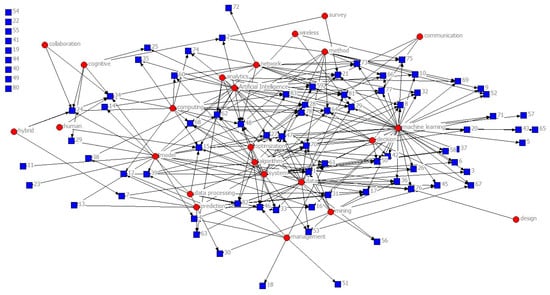
Figure 11.
Keywords Network by UCINET Software.
In Figure 11, nodes and leaves can be identified. The nodes are represented by red circles and are correspond to the most common keywords, where the words “machine”, “learning”, “artificial”, and “intelligence” have been united to form the key words “machine learning” and “artificial intelligence”.
The leaves, on the other hand, are represented by blue squares and correspond to the articles. To facilitate reading, the document titles were not inserted, but the (Identification) ID count for each of them is shown in the Appendix A.
The first thing that can be noticed is the isolation of many leaves that are not connected to the nodes. This means that the corresponding documents are not described by the keywords represented by the nodes. Really, they are characterized by keywords that have a frequency of the order of units.
Another thing that easily jumps to the eye is a density that is larger around the keywords “machine learning”, “decision”, “data”, “algorithm”, “system”, “artificial intelligence”, “method”, and “optimization”. This density is reflected in the cloud and the box chart produced by NVivo 12. Therefore, we can say that those are the words that most often appear in the documents analyzed, emphasizing, once again, that they include terms that do not just refer to the technology object of study but also to other fields of application.
3.3. Phase 3: Discussion
3.3.1. Benefits of Artificial Intelligence and Machine Learning in Industrial Contexts
From the analysis of the research carried out, the first information that emerged is that there is a growing importance of innovation and digitalization in products, services, and processes. Consequently, it means that the adoption of advanced manufacturing technologies, such AI and ML, is an emerging issue. In other words, AI/ML algorithms represent an opportunity to handle high dimensional problems and data. The interest in the subject is extended to all scientific sectors, but with a focus on computer science and engineering.
The most significant benefits of using AI and ML in industrial sectors include: (1) Greater innovation, (2) process optimization, (3) resources optimization, and (4) improved quality.
After all, AI with ML is one of the most important technologies today and is transforming the economy and society, as demonstrated by the over 340,000 patent applications filed since the 1950s.
Other information that emerged is about the authors and affiliation. Many of these are in a 1:1 ratio compared to the selected documents and this supports the fact that there is no interest in technological applications in one direction, but that, once again, the interest is very wide in the scientific community.
Furthermore, it can be said that the countries most interested in scientific research are the USA, China and European countries. This result is not a surprise.
In terms of investment, the effort currently being deployed by the United States and China to acquire dominance in the AI sector is far superior to that of other countries. More specifically, China has clearly stated its ambition to become a world leader in AI by 2030 [31]. Among the Chinese plans, of absolute interest is the “Made in China 2025” plan, dedicated to the manufacturing sector; the “Internet +” plan is also dedicated to smart manufacturing and innovation.
A direct consequence of the above considerations could be having new generations of researchers who will contribute to future comparisons, accompanied by new questions for investigations.
3.3.2. Emerging Trends of Artificial Intelligence and Machine Learning in Sustainable Manufacturing
From the perspective of sustainability, the analysis highlighted that the new paradigm of smart manufacturing has the potential to bring fundamental improvements in the industry by addressing the issue of scarce resources and improving productivity.
In fact, the survey pointed out a growing interest on applications related to green manufacturing and sustainable development, proving that AI/ML play an important role in increasing sustainability through the intelligent utilization of materials and energy consumption (i.e., reduction of energy consumption and pollutant emissions, environmental footprint monitoring and evaluation, etc.).
Furthermore, it emerged that AI/ML algorithms present a wide array of applications that provide an opportunity for sustainable development, which will involve several stakeholders from different countries and sectors, including inventory and supply chain management, predictive maintenance, and production.
In particular, Pérez-Ortiz, Jiménez-Fernández, Gutiérrez et al. [32] reviewed the most important classification algorithms applied to renewable energy (RE) problems. The main use of algorithms is as a tool for predictive analysis and consequently for data preprocessing, result interpretation, or evaluation in order to improve energy and resource management.
In this context, it also emerged that AI/ML have been successfully utilized in various processes’ optimization, applications in manufacturing, and predictive maintenance in different industries.
The work published by Lieber, Stolpe, Konrad et al. [33] represents a good research within steel industry production. It proposes an approach for automatically preprocessing value series data to improve the quality of the process and products. It means that AI/ML techniques were found to provide promising potential for improved quality control optimization in manufacturing systems.
Appropriate adoption of AI/ML technologies will promote sustainable manufacturing and the formation of a new generation of intelligent manufacturing, including all areas that characterize a sustainable process, ranging from the supply chain management to quality control, to predictive maintenance, to energy consumption.
Table 5 summarizes the main areas in sustainable manufacturing, their respective key objectives, and the main AI/ML applications.

Table 5.
Main areas in sustainable manufacturing.
However, the relationship between I.4 technologies, AI/ML, and sustainability demands a more conceptual and empirical investigation. This is corroborated by an article recently published in Nature Sustainability by the director of the Earth Institute at Columbia University, Jeffrey Sachs, and other experts, and the so-called Fourth Industrial Revolution (made of artificial intelligence and other digital technologies) is even cited as one of the six transformations necessary to achieve the sustainable development goals [34].
4. Conclusions
This research focused on the study of the state of the art of AI and ML applications, selecting literature on what has now become a particularly hot topic in scientific research. The literature available on any subject is now wide and a complete coverage of all the documents published with respect to a particular topic can be challenging or even impossible. Therefore, a systematic selection of the most relevant literature was implemented. This document provides a systematic review of applications in various scientific fields using ML techniques. For the selection of documents, objective and clear methods of investigation were used, independent of the experience of the researchers. Among the objectives of the document, it aimed to not only provide a comprehensive framework on the literature on the research of AI and ML but also a starting point for integrating knowledge through research in this area and to suggest future research paths. It is important to underline that this document was produced using only two databases, i.e., WoS and Scopus, in which only documents with open access were included. There are, therefore, many other documents with restricted access and other indexing databases, such as Google Scholar, that could be integrated for future research.
Author Contributions
All authors contributed equally to this work. All authors have read and agreed to the published version of the manuscript.
Funding
This work has been conducted under the framework of the Italian project “Linee Guida per I4.0-Campania”—funded by Regione Campania within POR FSE 2014–2020 Asse IV “Capacità istituzionale e amministrativa” objectives 18 (RA) 11.3 and 21 (RA) 11.6.
Conflicts of Interest
The authors declare no conflict of interest.
Appendix A
| ID Count | Research Source | ID Doc | Year | Title | Authors | Source Title | TC |
| 1 | SCP | 2 | 2006 | Machine learning in bioinformatics | Larrañaga, P.; Calvo, B.; Santana, R.; Bielza, C.; Galdiano, J.; Inza, I.; Lozano, J.A.; Armañanzas, R.; Santafé, G.; Pérez, A.; Robles, V. | Briefings in Bioinformatics | 298 |
| 2 | WoS | 62 | 2008 | Data-driven modelling: Some past experiences and new approaches | Solomatine, D.P.; Ostfeld, A. | Journal of Hydroinformatics | 160 |
| 3 | SCP | 26 | 2016 | Learning from imbalanced data: Open challenges and future directions | Krawczyk, B. | Progress in Artificial Intelligence | 119 |
| 4 | WoS | 63 | 2001 | Computer go: An AI oriented survey | Bouzy, B; Cazenave, T | Artificial Intelligence | 114 |
| 5 | SCP | 6 | 2008 | Structured machine learning: The next ten years | Dietterich, T.G.; Domingos, P.; Getoor, L.; Muggleton, S.; Tadepalli, P. | Machine Learning | 75 |
| 6 | SCP | 28 | 2016 | Machine learning in manufacturing: Advantages, challenges, and applications | Wuest, T.; Weimer, D.; Irgens, C.; Thoben, K.D. | Production and Manufacturing Research | 52 |
| 7 | WoS | 64 | 2017 | Machine learning paradigms for next-generation wireless networks | Jiang, C.; Zhang, H.; Ren, Y.; Han, Z.; Chen, K.C.; Hanzo, L. | Ieee Wireless Communications | 50 |
| 8 | SCP | 3 | 2006 | Machine learning techniques in disease forecasting: A case study on rice blast prediction | Kaundal, R.; Kapoor, A.A.; Raghava, G.P.S. | BMC Bioinformatics | 48 |
| 9 | SCP | 4 | 2008 | A comparison of machine learning algorithms for chemical toxicity classification using a simulated multi-scale data model | Judson, R.; Elloumi, F.; Woodrow, R.W.; Li, Z.; Shah, I. | BMC Bioinformatics | 45 |
| 10 | SCP | 19 | 2015 | A review of intelligent driving style analysis systems and related artificial intelligence algorithms | Meiring, G.A.M.; Myburgh, H.C. | Sensors (Switzerland) | 33 |
| 11 | SCP | 21 | 2016 | A machine learning framework for gait classification using inertial sensors: Application to elderly, post-stroke and huntington’s disease patients | Mannini, A.; Trojaniello, D.; Cereatti, A.; Sabatini, A.M. | Sensors | 31 |
| 12 | SCP | 1 | 2006 | Application of machine learning in SNP discovery | Matukumalli, L.K.; Grefenstette, J.J.; Hyten, D.L.; Choi, I.Y.; Cregan, P.B.; Van Tassell, C.P. | BMC Bioinformatics | 30 |
| 13 | SCP | 10 | 2013 | Beam search algorithms for multilabel learning | Kumar, A.; Vembu, S.; Menon, A.K.; Elkan, C. | Machine Learning | 29 |
| 14 | WoS | 65 | 2011 | Recommender Systems: An Overview | Burke, Robin; Felfernig, Alexander; Goeker, M.H. | Ai Magazine | 29 |
| 15 | SCP | 11 | 2013 | Biomedical informatics for computer-aided decision support systems: A survey | Belle, A.; Kon, M.A.; Najarian, K. | The Scientific World Journal | 27 |
| 16 | SCP | 23 | 2016 | Application of machine learning to construction injury prediction | Tixier, A.J.P.; Hallowell, M.R.; Rajagopalan, B.; Bowman, D. | Automation in Construction | 21 |
| 17 | SCP | 12 | 2013 | Quality prediction in interlinked manufacturing processes based on supervised & unsupervised machine learning | Lieber, D.; Stolpe, M.; Konrad, B.; Deuse, J.; Morik, K. | Procedia CIRP | 18 |
| 18 | SCP | 29 | 2016 | Semantic framework of internet of things for smart cities: Case studies | Zhang, N.; Chen, H.; Chen, X.; Chen, J. | Sensors | 17 |
| 19 | SCP | 20 | 2015 | Support vector machines in structural engineering: A review | Çevik, A.; KURTOĞLU, A.E.; Bilgehan, M.; Gülşan, M.E.; Albegmprli, H.M. | Journal of Civil Engineering and Management | 15 |
| 20 | SCP | 25 | 2016 | A review of classification problems and algorithms in renewable energy applications | Pérez-Ortiz, M.; Jiménez-Fernández, S.; Gutiérrez, P.A.; (…); Hervás-Martínez, C.; Salcedo-Sanz, S. | Energies | 15 |
| 21 | SCP | 43 | 2018 | Artificial intelligence (AI) methods in optical networks: A comprehensive survey | Mata, J.; de Miguel, I.; Durán, R.J.; (…); Jukan, A.; Chamania, M. | Optical Switching and Networking | 15 |
| 22 | SCP | 14 | 2014 | Fault diagnosis of automobile gearbox based on machine learning techniques | Praveenkumar, T.; Saimurugan, M.; Krishnakumar, P.; Ramachandran, K.I. | Procedia Engineering | 14 |
| 23 | SCP | 16 | 2014 | Improving active Mealy machine learning for protocol conformance testing | Aarts, F.; Kuppens, H.; Tretmans, J.; Vaandrager, F.; Verwer, S. | Machine Learning | 11 |
| 24 | WoS | 66 | 2016 | Strategies and Principles of Distributed Machine Learning on Big Data | Xing, E.P.; Ho, Q.; Xie, P.; Wei, D. | Engineering | 11 |
| 25 | WoS | 67 | 2015 | Recent advances on artificial intelligence and learning techniques in cognitive radio networks | Abbas, N.; Nasser, Y.; El Ahmad, K. | Eurasip Journal on Wireless Communications and Networking | 11 |
| 26 | WoS | 68 | 2018 | Artificial intelligence (AI) methods in optical networks: A comprehensive survey | Mata, J.; de Miguel, I.; Duran, R.J.; Merayo, N.; Singh, S.K.; Jukan, A.; Chamania, M. | Optical Switching and Networking | 9 |
| 27 | SCP | 40 | 2018 | A big data driven sustainable manufacturing framework for condition-based maintenance prediction | Kumar, A.; Shankar, R.; Thakur, L.S. | Journal of Computational Science 27, pp. 428–439 | 8 |
| 28 | WoS | 69 | 2017 | Research and Application of a Novel Hybrid Model Based on Data Selection and Artificial Intelligence Algorithm for Short Term Load Forecasting | Yang, W.; Wang, J.; Wang, R. | Entropy | 8 |
| 29 | SCP | 33 | 2017 | Context Aware Process Mining in Logistics | Becker, T.; Intoyoad, W. | Procedia CIRP | 7 |
| 30 | SCP | 24 | 2016 | Applications of machine learning methods to identifying and predicting building retrofit opportunities | Marasco, D.E.; Kontokosta, C.E. | Energy and Buildings | 6 |
| 31 | SCP | 37 | 2017 | Operational Demand Forecasting in District Heating Systems Using Ensembles of Online Machine Learning Algorithms | Johansson, C.; Bergkvist, M.; Geysen, D.; (…); Lavesson, N.; Vanhoudt, D. | Energy Procedia | 6 |
| 32 | WoS | 70 | 2018 | Advances in Multiple Criteria Decision Making for Sustainability: Modeling and Applications | Shen, K.Y.; Tzeng, G.H. | Sustainability | 6 |
| 33 | WoS | 71 | 2017 | Hybrid-augmented intelligence: Collaboration and cognition | Zheng, N.N.; Liu, Z.Y.; Ren, P.J.; Ma, Y.Q.; Chen, S.T.; Yu, S.Y.; Xue, J.R.; Chen, B.D.; Wang, F.Y. | Frontiers of Information Technology & Electronic Engineering | 6 |
| 34 | SCP | 5 | 2008 | Performance evaluation of the NVIDIA GeForce 8800 GTX GPU for machine learning | El Zein, A.; McCreath, E.; Rendell, A.; Smola, A. | Lecture Notes in Computer Science (including subseries Lecture Notes in Artificial Intelligence and Lecture Notes in Bioinformatics) 5101 LNCS(PART 1), pp. 466–475 | 5 |
| 35 | SCP | 7 | 2011 | A review of artificial intelligence algorithms in document classification | Bilski, A. | International Journal of Electronics and Telecommunications | 5 |
| 36 | SCP | 18 | 2015 | An architecture for agile machine learning in real-time applications | Schleier-Smith, J. | Proceedings of the ACM SIGKDD International Conference on Knowledge Discovery and Data Mining | 4 |
| 37 | SCP | 52 | 2018 | Machine learning in agriculture: A review | Liakos, K.G.; Busato, P.; Moshou, D.; Pearson, S.; Bochtis, D. | Sensors | 4 |
| 38 | SCP | 22 | 2016 | Application of Information Processes Applicative Modelling to Virtual Machines Auto Configuration | Zykov, S.; Shumsky, L. | Procedia Computer Science | 3 |
| 39 | SCP | 34 | 2017 | Geometry-aware principal component analysis for symmetric positive definite matrices | Horev, I.; Yger, F.; Sugiyama, M. | Machine Learning | 3 |
| 40 | SCP | 17 | 2015 | A Fuzzy Least Squares Support Tensor Machines in Machine Learning | Zhang, R.; Zhou, Z. | International Journal of Emerging Technologies in Learning | 2 |
| 41 | SCP | 36 | 2017 | Nuclear energy system’s behavior and decision making using machine learning | Gomez Fernandez, M.; Tokuhiro, A.; Welter, K.; Wu, Q. | Nuclear Engineering and Design | 2 |
| 42 | SCP | 9 | 2013 | Application study of machine learning in lightning forecasting | Qiu, T.; Zhang, S.; Zhou, H.; Bai, X.; Liu, P. | Information Technology Journal | 1 |
| 43 | SCP | 30 | 2016 | WOWMON: A machine learning-based profiler for self-adaptive instrumentation of scientific workflows | Zhang, X.; Abbasi, H.; Huck, K.; Malony, A.D. | Procedia Computer Science | 1 |
| 44 | SCP | 31 | 2017 | An event search platform using machine learning | Rodrigues, M.A.; Silva, R.R.; Bernardino, J. | Proceedings of the International Conference on Software Engineering and Knowledge Engineering, SEKE | 1 |
| 45 | SCP | 32 | 2017 | Automated business process management-in times of digital transformation using machine learning or artificial intelligence | Paschek, D.; Luminosu, C.T.; Draghici, A. | MATEC Web of Conferences | 1 |
| 46 | SCP | 42 | 2018 | Application of machine learning methods in big data analytics at management of contracts in the construction industry | Valpeters, M.; Kireev, I.; Ivanov, N. | MATEC Web of Conferences | 1 |
| 47 | SCP | 48 | 2018 | Data mining and machine learning in textile industry | Yildirim, P.; Birant, D.; Alpyildiz, T. | Wiley Interdisciplinary Reviews: Data Mining and Knowledge Discovery | 1 |
| 48 | WoS | 72 | 2018 | Big Data Analytics, Machine Learning, and Artificial Intelligence in Next-Generation Wireless Networks | Kibria, M.G.; Kien, N.; Villardi, G.P.; Zhao, O.; Ishizu, K.; Kojima, F. | Ieee Access | 1 |
| 49 | WoS | 73 | 2017 | Quantum neuromorphic hardware for quantum artificial intelligence | Prati, E. | 8th International Workshop Dice2016: Spacetime - Matter - Quantum Mechanics | 1 |
| 50 | WoS | 74 | 2015 | Exploiting Computational intelligence Paradigms in e-Technologies and Activities | Said, H.M.; Salem, A.M. | International Conference on Communications, Management, and Information Technology (Iccmit’2015) | 1 |
| 51 | WoS | 75 | 2012 | Sentiment Analysis of Products Using Web | Unnamalai, K. | International Conference on Modelling Optimization and Computing | 1 |
| 52 | SCP | 8 | 2012 | Taxonomy development and its impact on a self-learning e-recruitment system | Faliagka, E.; Karydis, I.; Rigou, M.; (…); Tsakalidis, A.; Tzimas, G. | IFIP Advances in Information and Communication Technology | 0 |
| 53 | SCP | 13 | 2013 | Research on adaptive multi-filtering model of network sensitive information | Cao, X.F.; Kang, W.; Shi, Q.; Shi, F.F. | Information Technology Journal | 0 |
| 54 | SCP | 15 | 2014 | Grade: Machine-learning support for graduate admissions | Waters, A.; Miikkulainen, R. | AI Magazine | 0 |
| 55 | SCP | 27 | 2016 | Leveraging linked open data information extraction for data mining applications | Mahule, R.; Vyas, O.P. | Turkish Journal of Electrical Engineering and Computer Sciences | 0 |
| 56 | SCP | 38 | 2017 | Rapid prototyping IoT solutions based on Machine Learning | Rizzo, A.; Montefoschi, F.; Caporali, M.; (…); Burresi, G.; Giorgi, R. | ACM International Conference Proceeding Series | 0 |
| 57 | SCP | 39 | 2017 | Towards automatic learning of heuristics for mechanical transformations of procedural code | Vigueras, G.; Carro, M.; Tamarit, S.; Mariño, J. | Electronic Proceedings in Theoretical Computer Science, EPTCS | 0 |
| 58 | SCP | 41 | 2018 | Application of artificial intelligence principles in mechanical engineering | Zajačko, I.; Gál, T.; Ságová, Z.; Mateichyk, V.; Wiecek, D. | MATEC Web of Conferences | 0 |
| 59 | SCP | 44 | 2018 | Artificial Intelligence in Medical Applications | Chan, Y.K.; Chen, Y.F.; Pham, T.; Chang, W.; Hsieh, M.Y. | Journal of Healthcare Engineering | 0 |
| 60 | SCP | 45 | 2018 | A semantic internet of things framework using machine learning approach based on cloud computing | Ding, P.W.; Hsu, I.C. | ACM International Conference Proceeding Series | 0 |
| 61 | SCP | 46 | 2018 | A Survey on Machine Learning-Based Mobile Big Data Analysis: Challenges and Applications | Xie, J.; Song, Z.; Li, Y.; (…); Zhang, J.; Guo, J. | Wireless Communications and Mobile Computing | 0 |
| 62 | SCP | 47 | 2018 | Big Data and Machine Learning Based Secure Healthcare Framework | Kaur, P.; Sharma, M.; Mittal, M. | Procedia Computer Science | 0 |
| 63 | SCP | 49 | 2018 | Discovering discontinuity in big financial transaction data | Tuarob, S.; Strong, R.; Chandra, A.; Tucker, C.S. | ACM Transactions on Management Information Systems | 0 |
| 64 | SCP | 50 | 2018 | Introducing children to machine learning concepts through hands-on experience | Hitron, T.; Erel, H.; Wald, I.; Zuckerman, O. | IDC 2018 - Proceedings of the 2018 ACM Conference on Interaction Design and Children | 0 |
| 65 | SCP | 51 | 2018 | Machine learning for software engineering: Models, methods, and applications | Meinke, K.; Bennaceur, A. | Proceedings - International Conference on Software Engineering | 0 |
| 66 | SCP | 53 | 2018 | Machine Learning in IT Service Management | Zuev, D.; Kalistratov, A.; Zuev, A. | Procedia Computer Science | 0 |
| 67 | SCP | 54 | 2018 | Research and application of computer control system based on complex neural network | Yang, R. | MATEC Web of Conferences | 0 |
| 68 | SCP | 55 | 2018 | Text classification techniques: A literature review | Thangaraj, M.; Sivakami, M. | Interdisciplinary Journal of Information, Knowledge, and Management | 0 |
| 69 | SCP | 56 | 2019 | A Machine Learning Method for Predicting Driving Range of Battery Electric Vehicles | Sun, S.; Zhang, J.; Bi, J.; Wang, Y.; Moghaddam, M.H.Y. | Journal of Advanced Transportation | 0 |
| 70 | SCP | 57 | 2019 | An empirical comparison of machine-learning methods on bank client credit assessments | Munkhdalai, L.; Munkhdalai, T.; Namsrai, O.E.; Lee, J.Y.; Ryu, K.H. | Sustainability | 0 |
| 71 | SCP | 58 | 2019 | Comparison of multiple linear regression, artificial neural network, extreme learning machine, and support vector machine in deriving operation rule of hydropower reservoir | Niu, W.J.; Feng, Z.K.; Feng, B.F.; (…); Cheng, C.T.; Zhou, J.Z. | Water | 0 |
| 72 | SCP | 59 | 2019 | Development and evaluation of a low-cost and smart technology for precision weed management utilizing artificial intelligence | Partel, V.; Charan Kakarla, S.; Ampatzidis, Y. | Computers and Electronics in Agriculture | 0 |
| 73 | SCP | 60 | 2019 | Identifying known and unknown mobile application traffic using a multilevel classifier | Zhao, S.; Chen, S.; Sun, Y.; (…); Su, J.; Su, C. | Security and Communication Networks | 0 |
| 74 | SCP | 61 | 2019 | Optimized Clustering Algorithms for Large Wireless Sensor Networks: A Review | Wohwe Sambo, D.; Yenke, B.O.; Förster, A.; Dayang, P. | Sensors | 0 |
| 75 | WoS | 76 | 2019 | FPGA-Based Accelerators of Deep Learning Networks for Learning and Classification: A Review | Shawahna, A.; Sait, S.M.; El-Maleh, A. | Ieee Access | 0 |
| 76 | WoS | 77 | 2018 | A quantum machine learning algorithm based on generative models | Gao, X.; Zhang, Z.Y.; Duan, L.M. | Science Advances | 0 |
| 77 | WoS | 78 | 2018 | Machine Learning for Network Automation: Overview, Architecture, and Applications | Rafique, D.; Velasco, L. | Journal of Optical Communications and Networking | 0 |
| 78 | WoS | 79 | 2018 | A wireless sensor data-based coal mine gas monitoring algorithm with least squares support vector machines optimized by swarm intelligence techniques | Chen, P.; Xie, Y.; Jin, P.; Zhang, D. | International Journal of Distributed Sensor Networks | 0 |
| 79 | WoS | 80 | 2017 | Nuclear energy system’s behavior and decision making using machine learning | Fernandez, M.G.; Tokuhiro, A.; Welter, K.; Wu, Q. | Nuclear Engineering and Design | 0 |
| 80 | WoS | 81 | 2017 | Automated business process management—In times of digital transformation using machine learning or artificial intelligence | Paschek, D.; Luminosu, C.T.; Draghici, A. | 8th International Conference on Manufacturing Science and Education (Mse 2017)—Trends in New Industrial Revolution | 0 |
| 81 | WoS | 82 | 2017 | The Evaluation of Resonance Frequency for Piezoelectric Transducers by Machine Learning Methods | Chang, F.M. | 27Th International Conference on Flexible Automation and Intelligent Manufacturing, Faim 2017 | 0 |
| 82 | WoS | 83 | 2017 | From Extraction to Generation of Design Information Paradigm Shift in Data Mining via Evolutionary Learning Classifier System | Chiba, K.; Nakata, M. | International Conference on Computational Science (Iccs 2017) | 0 |
References
- Gupta, N.A. Literature Survey on Artificial Intelligence. 2017. Available online: https://www.ijert.org/research/a-literature-survey-on-artificial-intelligence-IJERTCONV5IS19015.pdf (accessed on 7 January 2020).
- McCarthy, J.; Minsky, M.L.; Rochester, N.; Shannon, C.E. A Proposal for the Dartmouth Summer Research Project on Artificial Intelligence. AI Mag. 2006, 27, 12. [Google Scholar]
- Moore, A. Carnegie Mellon Dean of Computer Science on the Future of AI. Available online: https://www.forbes.com/sites/peterhigh/2017/10/30/carnegie-mellon-dean-of-computer-science-on-the-future-of-ai/#3a283c652197 (accessed on 7 January 2020).
- Becker, A.; Bar-Yehuda, R.; Geiger, D. Randomised algorithms for the loop cutset problem. J. Artif. Intell. Res. 2000, 12, 219–234. [Google Scholar] [CrossRef]
- Singer, J.; Gent, I.P.; Smaill, A. Backbone fragility and the local search cost peak. J. Artif. Intell. Res. 2000, 12, 235–270. [Google Scholar] [CrossRef]
- Chen, X.; Van Beek, P. Conflict-directed backjumping revisited. J. Artif. Intell. Res. 2001, 14, 53–81. [Google Scholar] [CrossRef]
- Hong, J. Goal recognition through goal graph analysis. J. Artif. Intell. Res. 2001, 15, 1–30. [Google Scholar] [CrossRef]
- Stone, P.; Littman, M.L.; Singh, S.; Kearns, M. ATTAC-2000: An adaptive autonomous bidding agent. J. Artif. Intell. Res. 2000, 15, 189–206. [Google Scholar] [CrossRef]
- Peng, Y.; Zhang, X. Integrative data mining in systems biology: from text to network mining. Artif. Intell. Med. 2007, 41, 83–86. [Google Scholar] [CrossRef]
- Zhou, X.; Liu, B.; Wu, Z.; Feng, Y. Integrative mining of traditional Chines medicine literature and MEDLINE for functional gene networks. Artif. Intell. Med. 2007, 41, 87–104. [Google Scholar] [CrossRef]
- Wang, S.; Wang, Y.; Du, W.; Sun, F.; Wang, X.; Zhou, C.; Liang, Y. A multi-approaches-guided genetic algorithm with application to operon prediction. Artif. Intell. Med. 2007, 41, 151–159. [Google Scholar] [CrossRef]
- Halal, W.E. Artificial intelligence is almost here. Horizon 2003, 11, 37–38. Available online: https://www.emerald.com/insight/content/doi/10.1108/10748120310486771/full/html (accessed on 7 January 2020). [CrossRef]
- Masnikosa, V.P. The fundamental problem of an artificial intelligence realization. Kybernetes 1998, 27, 71–80. [Google Scholar] [CrossRef]
- Metaxiotis, K.; Ergazakis, K.; Samouilidis, E.; Psarras, J. Decision support through knowledge management: The role of the artificial intelligence. Inf. Manag. Comput. Secur. 2003, 11, 216–221. [Google Scholar] [CrossRef]
- Raynor, W.J. The international dictionary of artificial intelligence. Ref. Rev. 2000, 14, 1–380. [Google Scholar]
- Stefanuk, V.L.; Zhozhikashvili, A.V. Productions and rules in artificial intelligence. Kybernetes 2002, 31, 817–826. [Google Scholar] [CrossRef]
- Tay, D.P.H.; Ho, D.K.H. Artificial intelligence and the mass appraisal of residential apartments. J. Prop. Valuat. Invest. 1992, 10, 525–540. [Google Scholar] [CrossRef]
- Wongpinunwatana, N.; Ferguson, C.; Bowen, P. An experimental investigation of the effects of artificial intelligence systems on the training of novice auditors. Manag. Audit. J. 2000, 15, 306–318. [Google Scholar] [CrossRef]
- Oke, S.A. A literature review on artificial intelligence. Int. J. Inf. Manag. Sci. 2008, 19, 535–570. [Google Scholar]
- Carvalho, T.P.; Soares, F.A.A.M.N.; Vita, R.; da Francisco, P.R.; Basto, J.P.; Alcalá, S.G.S. A systematic literature review of machine learning methods applied to predictive maintenance. Comput. Ind. Eng. 2019, 1, 1–12. [Google Scholar] [CrossRef]
- Majorel Deutschland GmbH Artificial Intelligence and Sustainability. Available online: https://www.future-customer.com/artificial-intelligence-and-sustainability/ (accessed on 8 January 2020).
- Markham, I.S.; Mathieu, R.G.; Wray, B.A. Kanban setting through artificial intelligence: A comparative study of artificial neural networks and decision trees. Integr. Manuf. Syst. 2000, 11, 239–246. [Google Scholar] [CrossRef]
- Kotsiantis, S.B.; Zaharakis, I.; Pintelas, P. Supervised machine learning: A review of classification techniques. Emerg. Artif. Intell. Appl. Comput. Eng. 2007, 160, 3–24. [Google Scholar]
- Cortes, C.; Vapnik, V. Support-vector networks. Mach. Learn. 1995, 20, 273–297. [Google Scholar] [CrossRef]
- Kitchenham, B. Procedures for Performing Systematic Reviews. Technical Report TR/SE-0401. 2004. Available online: https://pdfs.semanticscholar.org/2989/0a936639862f45cb9a987dd599dce9759bf5.pdf?_ga=2.7241591.47522378.1578382825-243572483.1578382825 (accessed on 7 January 2020).
- Duan, Y.; Edwards, J.S.; Dwivedi, Y.K. Artificial intelligence for decision making in the era of Big Data—Evolution, challenges and research agenda. Int. J. Inf. Manag. 2019, 48, 63–71. [Google Scholar] [CrossRef]
- De Felice, F.; Petrillo, A.; Zomparelli, F. Prospective design of smart manufacturing: An Italian pilot case study. Manuf. Lett. 2018, 15, 81–85. [Google Scholar] [CrossRef]
- Larrañaga, P.; Calvo, B.; Santana, R.; Bielza, C.; Galdiano, J.; Inza, I.; Lozano, J.A.; Armañanzas, R.; Santafé, G.; Pérez, A.; et al. Machine Learning. in Bioinformatics. Brief. Bioinform. 2006, 7, 86–112. [Google Scholar] [CrossRef] [PubMed]
- Krawczyk, B. Learning from imbalanced data: Open challenges and future directions. Prog. Artif. Intell. 2016, 5, 221–232. [Google Scholar] [CrossRef]
- Wuest, T.; Weimer, D.; Irgens, C.; Thoben, K.D. Machine learning in manufacturing: Advantages, challenges, and applications. Prod. Manuf. Res. 2016, 4, 23–45. [Google Scholar] [CrossRef]
- Dutton, T. An Overview of National AI Strategies. Available online: http://www.jaist.ac.jp/~bao/AI/OtherAIstrategies/An%20Overview%20of%20National%20AI%20Strategies%20%E2%80%93%20Politics%20+%20AI%20%E2%80%93%20Medium.pdf (accessed on 8 January 2020).
- Pérez-Ortiz, M.; Jiménez-Fernández, S.; Gutiérrez, P.A.; Alexandre, E.; Hervás-Martínez, C.; Salcedo-Sanz, S. A Review of Classification Problems and Algorithms in Renewable Energy Applications. Energies 2016, 9, 607. [Google Scholar] [CrossRef]
- Lieber, D.; Stolpe, M.; Konrad, B.; Deuse, J.; Morik, K. Quality prediction in interlinked manufacturing processes based on supervised & unsupervised machine learning. Procedia CIRP 2013, 7, 193–198. [Google Scholar]
- Sachs, J.D.; Schmidt-Traub, G.; Mazzucato, M.; Messner, D.; Nakicenovic, N.; Rockström, J. Six Transformations to Achieve the Sustainable Development Goals. Nat. Sustain. 2019, 2, 805–814. [Google Scholar] [CrossRef]
© 2020 by the authors. Licensee MDPI, Basel, Switzerland. This article is an open access article distributed under the terms and conditions of the Creative Commons Attribution (CC BY) license (http://creativecommons.org/licenses/by/4.0/).